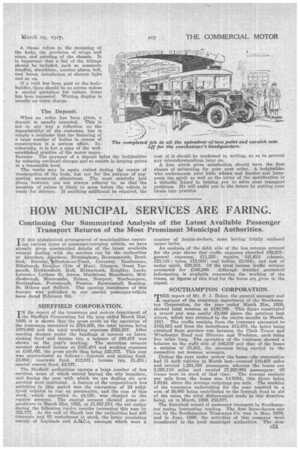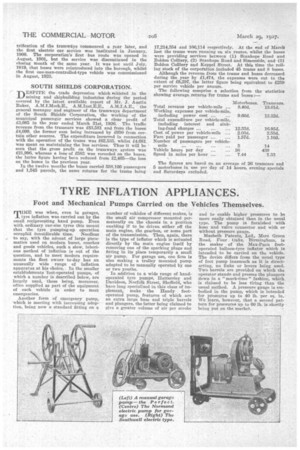HOW MUNICIPAL SERVICES ARE FARING.
Page 121

Page 122

If you've noticed an error in this article please click here to report it so we can fix it.
Continuing Our Summarized Analysis of The Latest Available Passenger Transport Returns of the Most Prominent Municipal Authorities.
IN this alphabetical arrangement of municipalities operat_Ling various types of passenger-carrying vehicle, we have already given summarized details of the latest available returns dealing with the services run 'by the authorities at Aberdare, Aberdeen, Birmingham, Bournemouth, Bradford, Burnlee, %Burton-on-Trent, Coventry, Eastbourne, Edinburgh, D'oullae (Isle of Man), Glasgow, Great Yarmouth, Huddersfield, Hull, Kilmarnock, Keighley, Leeds, Leicester, Lytham St. Armes, Maidstone, Manchester, Middlesbrough, Morecambe, Nelson, Newport, Northampton, Nottingham, Portsmouth, Preston, Rawteestall, Reading, St. Helens and Salford. The opening instalment of this feature was published in our special paseengevehicle issue dated February 8th, SHEFFIELD CORPORATION.
IN the repert of the tramways and motors department of the Sheffield Corporation for the year ended March 31st, 1926, it is shown that the gross profit on the operation of the tramways amounted to 1224,805, the total income being /878,062 and the total working expenses £653,257. After meeting charges under the headings of interest on loans, sinking fund and income tax, a balance of 198,473 was shown on the year's working. The motorbus revenue account showed income at £167,470 and working expenses at 1145,097, the gross profit thus being £22,373. This sum was appropriated as follows :—Interest and sinking fund, /3,904; renewals fund, £12,831; income tax, £1,451; special reserve fund, £4,187.
Tbe Sheffield authorities operate a large number of bus services, some of which extend beyond the city boundary, and during the year with which we are dealing six new services were instituted. A feature of the corporation's bus activities in this period was the conversion of 24 solidtyred vehicles to run on pneumatics, and the cost of this work, which amounted to £4,165, was charged to the repairs account. The capital account showed gross expenditure to March 31st, 1925, at /1,837,573, the net outlay during the following twelve months increasing this sum by 122,177. At the end of March last the authorities had 400 tramettis and 91 motorbuses in stock, the latter consisting mainly of Leylands and A.E.C.s, amongst which were a
number of double-deckers, some having totally enclosed upper decks.
An analysis of the debit side of the bus revenue account for the year shows that traffic expenses absorbed £62,833; general expenses, £11,255; repairs, 141,615 (chassis, £23,187; tyres £12,050; and bodies, 15,084), and cost of motor spirit, .£.29,353. Of the total income traffic revenue accounted for 1166,599. Although detailed statistical information is available concerning the working of the trams, no -figures of this kind for the buses are given in the report.
SOUTHAMPTON CORPORATION.
"report of Mr. P. J. Baker, the general manager and
engineer of the tramways department of the Southampton Corporation, for the year ended March 31st, 1926, showed total revenue at 1180,765. This figure constituted a record and was nearly £2,000 above the previous best return, which was obtained in the twelve months to March, 1921. The traffic receipts from the tramcars amounted to 1162,853 and from the motorbuses £12,478, the latter being obtained from services run between the Clock Tower and Winchester Road and Bitterne and Woolston, each being five miles long. The operation of the tramcars showed a balance on the right side of 146,519 and that of the buses a surplus of £3,431, the amounts being carried to the respective net revenue accounts.
During the year under review the buses—the corporation had 11 such vehicles in March last—covered 210,437 miles and carried 1,291,895 passengers, whereas the trams ran 2,355,110 miles and carried 27,922,601 passengers; 92 trams were in stock at that time. The average receipts per mile from the buses was 14.7081, this figure being 3.914d. above the average outgoings per mile. The working of the tramways undertaking for the year resulted in a sum of £8,000 being contributed to the borough fund in aid of the rates, the total disbursement made in this direction being, up to March, 1926, £84,877.
The historical record of passenger transport in Southampton makes interesting reading. The first horse-drawn car run by the Southampton Tramways Co. was in May, 1879, and in June, 1898, the activities of this company were transferred to the local municipal authorities. The eke trification of the tramways Commenced a year later, and the first electric car service was instituted in January, 1900. The corporation's first bus route was opened in August, 1901, but the service was discontinued in the closing month of the same year. It was not until July, 1919, that buses were reintroduced into the borough, whilst the first one-man-controlled-type vehicle was commissioned in August, 1923.
SOUTH SHIELDS CORPORATION.
1./ ESP1TE the trade depression which 'existed in the mining and shipbuilding industries during the period covered by the latest available report of Mr. J. Austin Baker, A.M.I.Mech.E., A.M.Inst.E.E., A.M.I.A.E., the general manager and engineer of the tramways department of the South Shields Corporation, the working of the municipal passenger services showed a clear profit of £3,085 in the year ended March 31st, 1926. The traffic revenue from the tramcars was £83,581 and from the buses £4,099, the former sum being increased by #950 from certain other sources. The expenditure incurred in connection with the operation of the trams was £62,535, whilst £4,681 was spent on maintaining the bus services. Thus it will be seen that the gross profit on the tramways system was £21,996, whereas a loss of £583 was recorded on the buses, the latter figure having been reduced from £2,465—the loss on the buses in the previous year.
In the twelve months the buses carried 558.166 passengers and 1,545 parcels, the same returns for the trams being
17,214,354 and 106,114 respectively. At the end of March last the trams were running on six routes, whilst the buses were providing services between (1) Stanhope Road and Boldon Colliery, (2) Stanhope Road and Simonside, and (3) 33oldon Colliery and Keppel Street. At this time the rolling stock of the corporation included 45 trams and 8 buses.
Although the revenue from the trams and buses decreased during the year by £1,474, the expenses were cut to the extent of £8,297, the latter figure being equivalent to £259 per service vehicle per annum. The following comprise a selection from the statistics showing average returns for trains and buses:— Total expenditure per vehicle-mile, including interest and sinking-fund charges ... Cost of power per vehicle-mile .. Fare paid per passenger ... ... Number of passengers per vehicle The figures are based on an average of 26 tramcars and 5 motorbuses in use per day of 14 hours, evening specials and Saturdays excluded.












































































































































































